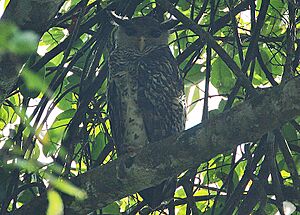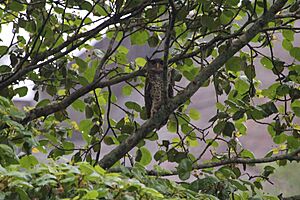Spot-bellied eagle-owl facts for kids
Quick facts for kids Spot-bellied eagle-owl |
|
|---|---|
 |
|
| Conservation status | |
| Scientific classification | |
| Genus: |
Ketupa
|
| Species: |
nipalensis
|
The spot-bellied eagle-owl (Ketupa nipalensis) is a big bird of prey. It is also called the forest eagle-owl. This owl looks very impressive and strong. It lives in forests across the Indian Subcontinent and Southeast Asia. It is closely related to the barred eagle-owl, which looks similar. However, these two owls live in different areas.
Contents
About the Spot-Bellied Eagle-Owl's Family Tree
Scientists group living things into categories. This helps us understand how they are related. The spot-bellied eagle-owl and its close relative, the barred eagle-owl, are now placed in a group called Ketupa.
For a long time, many owls, including these, were put into the Bubo group. This was because they seemed similar. But new studies, using DNA from their cells, showed they are different. The Ketupa owls, like the spot-bellied eagle-owl, are not always found near water. They also do not mainly eat fish, unlike some other owls. This is why they now have their own group.
What Does the Spot-Bellied Eagle-Owl Look Like?
The spot-bellied eagle-owl is a very large owl. It can be from 50 to 65 cm (20 to 26 in) long. This makes it one of the longest owls in the world. It also has very long wings.
These owls usually weigh between 1.5 to 2.5 kg (3.3 to 5.5 lb). Some might be smaller, around 1.3 to 1.5 kg (2.9 to 3.3 lb). A very large one was once thought to weigh 3 kg (6.6 lb).
The owl has long ear-tufts on its head. These tufts can be 63 to 76 mm (2.5 to 3.0 in) long. They look a bit messy at the ends. Like most eagle-owls, its legs and feet are covered in feathers. But the tips of its toes are bare. Its feet and talons are very big and strong.
Size Differences in Owls
Owls in Sri Lanka are a bit smaller than those in northern India. They are about 10% smaller in length. For example, a Sri Lankan owl had a wingspan of 143 cm (56 in). Its middle talon was 44.2 mm (1.7 in) long. This is quite large for its size.
The spot-bellied eagle-owl is mostly grayish-brown. Its back and upper wings are dark brown. Its throat and belly are pale with black and white stripes. These stripes become spots on its lower belly. Its wings have dark brown feathers with lighter stripes.

Young owls look different from adults. They are much paler and more grayish-cream. They have brownish stripes all over.
It is easy to tell this owl apart from others in its home. Most other eagle-owls in India and Southeast Asia do not live in deep forests. The spot-bellied eagle-owl is the largest owl in its area. Only the tawny fish owl is bigger, but it lives only near mountain streams.
The spot-bellied eagle-owl and the barred eagle-owl look similar. But they do not live in the same places. You can tell them apart from other eagle-owls by their pale, slanted ear-tufts. Also, their belly markings are horizontal stripes or spots, not vertical.
The Owl's Unique Calls
This owl is famous for its strange, human-like calls. In Sri Lanka, some people believe it is the mysterious "Devil Bird". This bird is known as ulama. In 2001, it was confirmed that the "Devil Bird" sounds like the spot-bellied eagle-owl.
Its call is a scream that goes up and then down in sound. The owl also makes low hooting sounds. These hoots are very deep and loud. They can be heard from far away. Owls that live in forests often have many different calls. This helps them communicate when they cannot see each other well.
Where Does the Spot-Bellied Eagle-Owl Live?
This owl lives in the Lower Himalayas, from Kumaon to Burma. It also lives in central Laos and central Vietnam. You can find them across the Indian subcontinent and Southeast Asia. Their range goes as far south as Sri Lanka and southern Thailand.
The spot-bellied eagle-owl mostly lives in old, untouched forests. They also like older second-growth forests. They prefer dense, evergreen forests or moist deciduous forests. They can also be found in tropical valleys and lower hills.
Even though they are thought to be rare, new photos show they are found in many parts of India. They might just be good at hiding. They live in different climates, from cool forests in Nepal to hot, humid rainforests. They mostly live in tropical and subtropical foothills. This is usually at heights of 900–1,200 m (3,000–3,900 ft). But they can live from sea-level up to 6,300 m (20,700 ft).
How the Spot-Bellied Eagle-Owl Behaves

The spot-bellied eagle-owl is a nocturnal animal. This means it is active at night. During the day, it usually hides in thick leaves of big trees. However, sometimes they are seen moving or even hunting during the day. This happens more in forests where people do not bother them much. They usually start hunting when the sun goes down.
What Does the Spot-Bellied Eagle-Owl Eat?
This owl is a very strong hunter. It is at the top of the food chain in its forest home. We do not have many detailed studies about what it eats. But most of the prey reported for this owl is very large. Often, the prey is as heavy or even heavier than the owl itself!
Many reports say this owl mainly eats pheasants. This includes junglefowl and kalij pheasants. These birds can weigh from 500 to 1,500 g (1.1 to 3.3 lb). They also eat Indian peafowl, which can weigh from 2.75 to 6 kg (6.1 to 13.2 lb). The owl pounces on these birds while they are sleeping in trees. Its strong talons can kill them very quickly.
The owl also eats many mammals. These range from small rodents to larger animals. It has been seen eating golden jackals, hares, large Indian civets, and even young muntjacs (small deer). These larger mammals can weigh 2 to 9 kg (4.4 to 19.8 lb) or more.
They also catch animals that live in trees. This includes the Indian giant squirrel and young purple-faced langur monkeys. They might also hunt toque monkeys. One owl was seen catching an Indian flying fox (a large bat) from its roost. Because they hunt some animals active during the day, it seems they sometimes hunt in daylight too.
They also eat snakes, lizards (even large monitor lizards), and fish. Like some other owls, they have been seen eating dead animals. They have been seen eating dead goats and even dead tigers.
Life Cycle and Reproduction
This owl's nesting season is from December to March. Sometimes, an egg has been found as late as June. Most nests are in large, empty tree hollows. They also use old nests made by other big birds. These can be nests built by eagles, vultures, or kites. They have also been found nesting in caves or cracks in rock walls.
This owl usually lays only one egg at a time. This is rare for owls. Only two other owl species are known to do this. The egg is white and round. It measures about 61.2 mm × 49.9 mm (2.4 in × 2.0 in). This is about the same size as eggs from the largest owls in the world.
It is thought that both parent owls might sit on the egg. But male owls usually do not do much egg sitting. The male might only cover the egg for a short time if the female leaves. We do not know much more about their breeding habits. This is because these owls are very protective of their nests. People have reported getting hurt when trying to get close to their nests. So, it is best to stay far away from active nests.
Conservation Status
This owl is not very common. It likely needs large areas to hunt and nest. This means there are not many of them in one place. However, they live across a very large area. So, they are not thought to be in danger of disappearing.
The biggest threat to this owl is when forests are cut down. They tend to leave areas where this happens. Even though we do not know their exact population size, the spot-bellied eagle-owl is listed as "least concern" on the IUCN Red List. This means they are not currently considered endangered.





